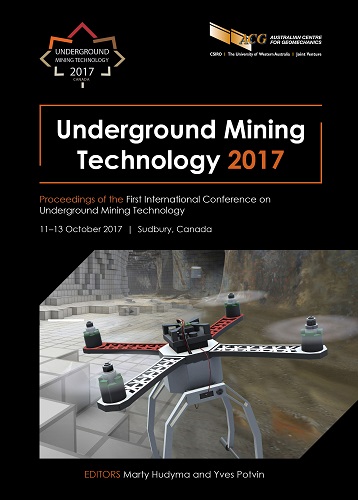Cave mining design methodology for use in challenging geomechanics environments

|
Authors: Ferguson, GA; Didyk, M; Zenteno, LF; San Martin, JF; Fowell, RJ |
DOI https://doi.org/10.36487/ACG_rep/1710_22_Ferguson
Cite As:
Ferguson, GA, Didyk, M, Zenteno, LF, San Martin, JF & Fowell, RJ 2017, 'Cave mining design methodology for use in challenging geomechanics environments', in M Hudyma & Y Potvin (eds), UMT 2017: Proceedings of the First International Conference on Underground Mining Technology, Australian Centre for Geomechanics, Perth, pp. 281-294, https://doi.org/10.36487/ACG_rep/1710_22_Ferguson
Abstract:
Underground cave mining design tends to rely upon empirical and numerical models, neither of which are able to close the engineering design loop. Such circumstances, mean that it is very difficult to analyse with certainty, the causes of significant problems that can arise from time to time. Widespread collapses and damaging mining-induced seismicity, have occurred, for example, within the El Teniente mine, and are examples of cave mining problems that appear to have been without resolution. Further, fundamental and relevant engineering design issues tend to be lost in a swathe of other issues, which have only minor importance, in comparison to the major concern in cave mining – that of long-term stability and productivity of the production complex. Cave mining design methodology put forward in this paper is based upon the fundamental precepts that: a detailed and in-depth knowledge and understanding of the geomechanics mechanisms involved in the response of the rock mass to the creation of excavations by mining is essential, selection of alternative design components is based upon quantitative risk analyses integrated within project cash flows, and successful implementation of mining designs requires that operators follow methodspecific mining tactics. Practical examples are outlined to illustrate the process.
Keywords: cave mining design, geomechanics in mine planning, risk-based decision-making
References:
Box, GEP 1979, ‘Robustness in the strategy of scientific model building’, in RL Launer & GN Wilkinson (eds), Robustness in Statistics, Academic Press, New York, pp. 201–236.
Brzovic, A 2016, Fracturamiento hidráulico para la gestión de la fragmentación de la roca primaria en mina el Teniente, GRMDSGLINF-0038-2016, Codelco Chile, Rancagua.
Dunlop, R & Blanco, B 2017, Sismicidad inducida TAP OIM PNNM, Nota Interna T11M408-I1-T11M408-06831-NOTGE04-6830-039, Codelco Chile, Rancagua.
Ferguson, GA 2015, Evolution of a design methodology for use in cave mines developed in challenging geomechanics environments, unpublished PhD thesis, The University of Leeds, Leeds.
Manthei, G, Philipp, J & Eisenblätter, J 2011 ‘Acoustic emission measurements in rock structures and on rock specimens’, memorandum from DGG Kolloquium Induzierte Seismizität, 23 February 2011, special issue I/2011 viewed 3 July 2017,
Manthei G, Eisenblätter, J & Kamlot P 2003, ‘Stress measurements in salt mines using a special hydraulic fracturing borehole tool’, in O Natau, E Fecker & E Pimentel (eds), Geotechnical Measurements and Modelling 2003 Swets & Zeitlinger, Lisse,
pp. 355–360.
Pariseau WG 1983, ‘Rock flow in ore passes’, Guidelines for Open-pit Ore Pass Design, vol. 1 – final report, Engineers International, Inc., viewed 3 July 2017, , 259 pp.
Salamon, MDG 1983, ‘Rockburst hazard and the fight for its alleviation in South African Gold Mines’, in IW Farmer (ed), Proceedings of Rockbursts: Prediction and Control, Institution of Mining and Metallurgy, London, pp. 11–36.
Zang, A, Stephansson, O, Stenberg, L, Plenkers, K, Specht, S, Milkereit, C, Schill, E, Kwiatek, G, Dresen, G, Zimmermann, G, Dahm,
T & Weber, M 2016, ‘Hydraulic fracture monitoring in hard rock at 410 m depth with an advanced fluid-injection protocol and extensive sensor array’, Geophysical Journal International, vol. 208, no. 2, pp. 790–813.
© Copyright 2025, Australian Centre for Geomechanics (ACG), The University of Western Australia. All rights reserved.
View copyright/legal information
Please direct any queries or error reports to repository-acg@uwa.edu.au
View copyright/legal information
Please direct any queries or error reports to repository-acg@uwa.edu.au